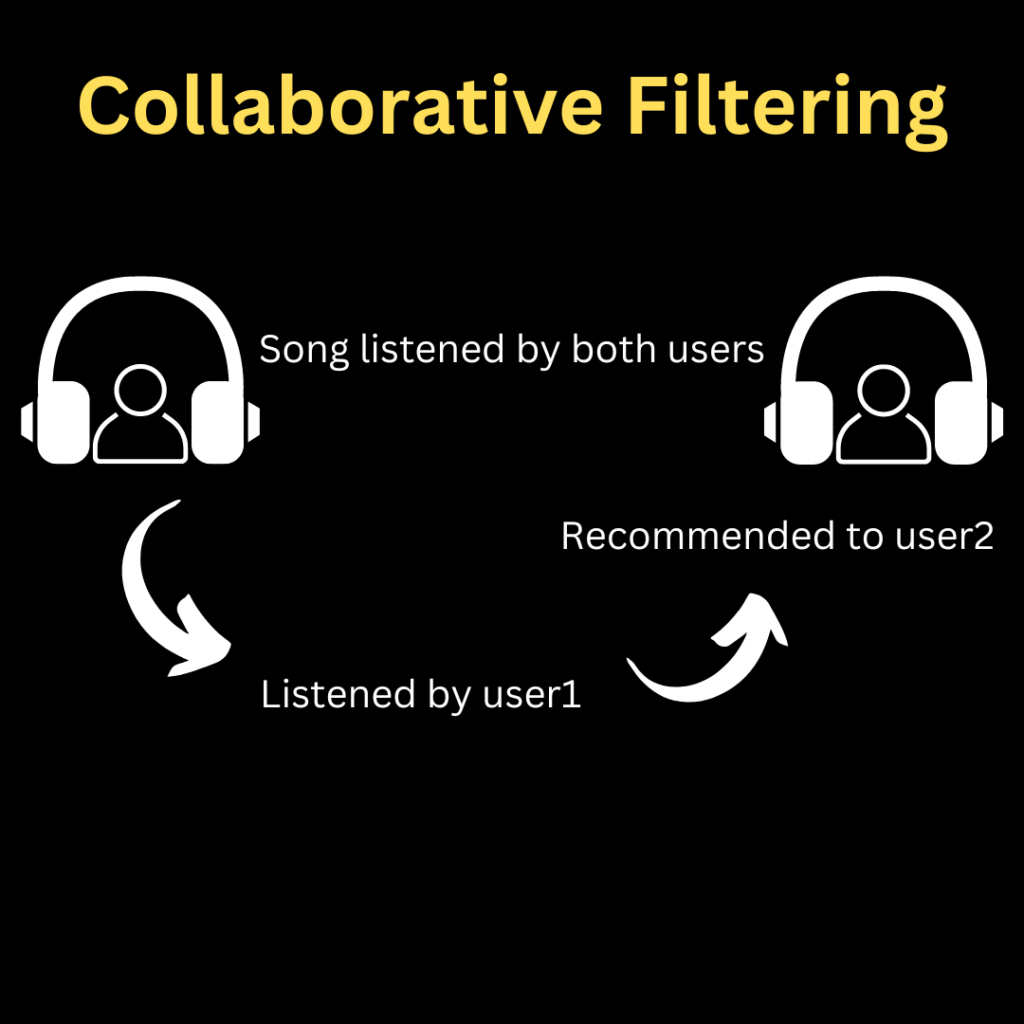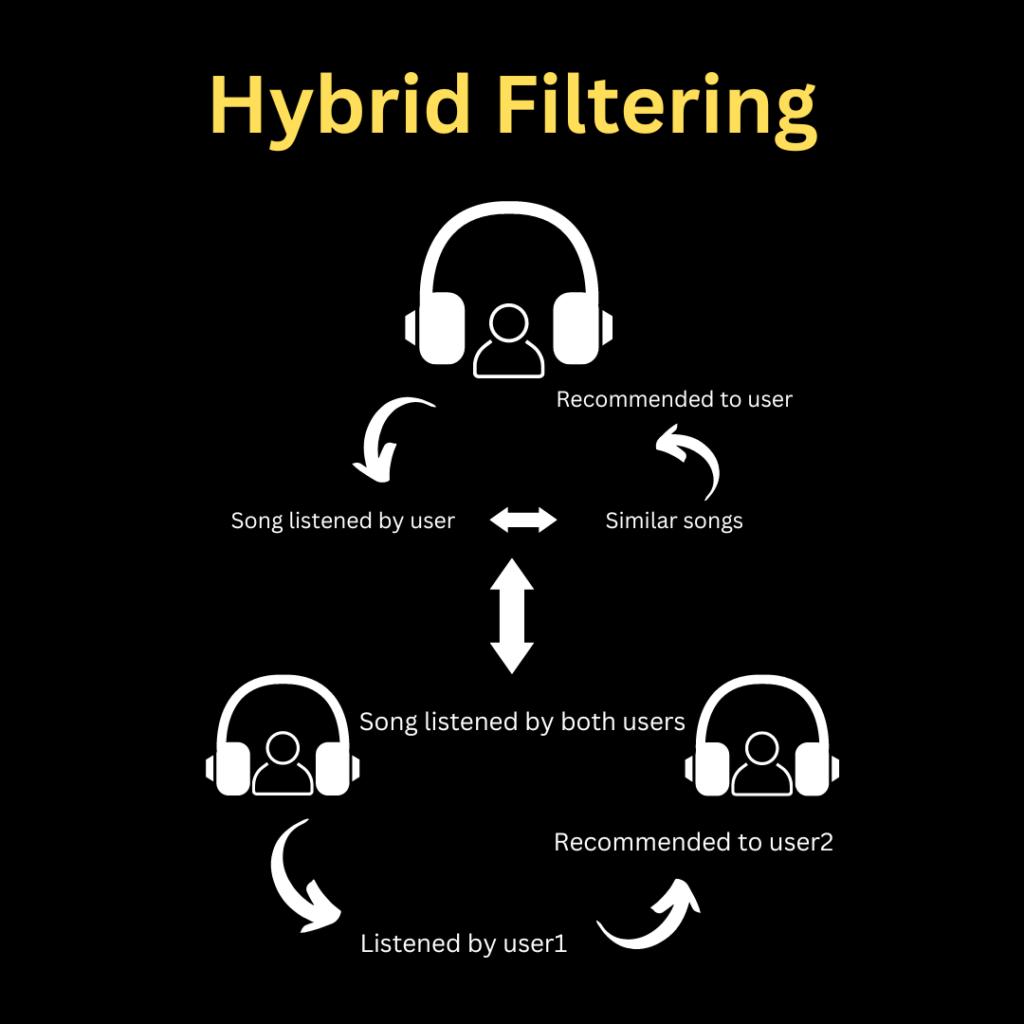In this article, we are discussing a music recommendation system using machine learning techniques briefly.
Need help with project? Contact at +91-9760648231(WhatsApp)
Introduction
You love listening to music right? Imagine hearing your favorite song on any online music platform let’s say Spotify. Suppose that the song’s finished, what now? Yes, the next song gets played automatically. Have you ever imagined, how so? What is the logic or piece of code behind this? The same case might happen to you while watching a movie on Netflix or buying something from Amazon. You get recommendations.
Precisely, these recommendations are system generated and the logic behind them is nothing but Machine Learning. Machine Learning is the ability to make machines learn and act. You search for some songs and listen to them and this is how the machine learns. It then recommends songs to you on the basis of various factors like singer or composer, movie, tone of the song, whether it is romantic or disco, it is acoustic or original, etc.

A recommendation system is a kind of filtering system which predicts the preferences a user might give based on his/her activity. Machine learning plays a super vital role in building these systems. This technique is widely popular and practiced in every streaming platform like YouTube, Amazon, Netflix, Spotify, Tidal, etc. You don’t have to play songs manually, instead, a music recommendation system will do that job for you.
How does a Music Recommendation System work?
There are basically 3 types of approaches used by recommendation systems to recommend entities.
1. Content-Based Filtering
2. Collaborative-Based Filtering
3. Hybrid
These filters are highly dependent upon the target. The model should have information about the target for eg, who the target is and what you know about them.
1. Content-Based Filtering:
As the name suggests, content-based filtering works on item features. This filtering method recommends new items having similar characteristics as the user’s previous engagements. To be precise, this method recommends items having similar features. For eg., if a user listening to music sung by, let’s say, an ABC artist, then the next music recommendations might be from the same artist. Here, the singer, composer, melody, tone of the music, language, etc are attributes or characteristics of that item.
This recommender system stores users’ data of clicks, feedback, likes, or engagement and from this data, it best recommends the next new item. The more this data is available and precise, the more the system works better.

The content-based filtering uses a utility matrix. The utility matrix consists of the rating or preference of each user-item pair. The data gathered from the day-to-day activity of the user is stored in the form of a matrix to find the likes or dislikes of the user with different items. We assign a particular value to each user-item pair, this value is known as the degree of preference. Then, the matrix of the user is drawn with the respective items to identify their preference relationship. Here, any user’s preference is not influenced by any other user’s preference.
2. Collaborative Filtering:
As the name suggests, this filtering method works on examining the pattern between the k users with similarities between them. For eg., if a customer buys item ‘a’ and item ‘b’ from the shop and the other customer buys item ‘a’, item ‘b’, and item ‘c’ then there might be a probability that the first customer will buy item ‘c’. Thus this mechanism is based on the past interactions that have been recorded between users and items. Here, we ignore the features or attributes of an item. Instead, we focus on the group of people liking the item and recommend other items to this group.
Indirectly, collaborative filtering classifies users into similar clusters and then recommends according to the user’s preference for its cluster.

The filtering uses a user-item interaction matrix. This matrix defines the interaction between the user to the item and it can be shown by the rating given by the users. In case there’s no explicit rating, the parameters like user searched for that item or clicked on that, etc are considered.
There are two types of collaborative filtering approaches:
1. Memory based: The user’s previous ratings and interactions from the user-item interaction matrix are used for new recommendations to users.
2. Model-based: The machine learning models are used to predict and rank the interactions between the user and items. These models are trained by applying algorithms like deep learning, clustering, matrix factorization, etc.
3. Hybrid Filtering:

This filtering is mostly used when there’s a lack of data to identify the relationship between an item and a user. Hybrid filtering is the approach based on content-based and collaborative filtering. An item is recommended to the user based on both ratings and interest. This filtering uses 7 approaches: mixed, switching, weighted, feature augmentation, feature combination, cascade, and meta-level. This filtering method covers the limitation caused by the above two filterings.
ML Techniques Used in Recommendation systems:
There are various approaches to building the recommendation system using ML algorithms. Some of them are:
- K- nearest neighbors:
kNN is a machine learning algorithm to find clusters of similar users based on common ratings and makes predictions using the average rating of top-k nearest neighbors. This algorithm can directly be implemented from the sklearn module in Python. - Decision Trees:
Decision trees are used as a model-based approach for recommender systems. The use of decision trees for building recommendation models offers benefits like efficiency and interpretability and flexibility in handling a variety of input data types. The decision tree forms a predictive model which maps the input to a predicted value based on the input’s attributes. A major limitation of using decision trees is the need to build a huge number of trees. - Neural Networks:
Neural networks are trained to approximate an objective function by minimizing the estimation error with a gradient descent algorithm. We can use their inherent optimization capability to perform matrix factorization. Matrix factorization is the way to generate latent features when multiplying two different kinds of entities. Collaborative filtering is the application of matrix factorization to identify the relationship between items’ and users’ entities. Neural network approaches like natural language processing, deep neural networks, etc are widely popular to build recommendation systems.
Matrix factorization, vectorization, cosine similarity, etc are the concepts used in implementing recommender systems.
Limitations
Recommender systems are wholly and solely based on the filtering approaches used in them. And hence, the limitations of a recommender system are nothing but the limitations of content-based filtering and collaborative filtering.
Content-Based Filtering:
- Content-based filtering is based on the attributes or characteristics of an item. Hence, there should be sufficient characteristics of an item to build this system.
- The feature representation of the items can be a hard task to some extent. And hence, a lot of skills and domain knowledge is required here.
- The model can recommend a new item to the user based on past interactions. And hence, there is a limited ability to discover and expand the new entrances.
- There might be cases where users haven’t really interacted and it is hard to predict or recommend.
- The cold start problem: Suggesting absolute new users is a limitation of this approach.
Collabative Filtering:
- Data sparsity: There might be chances that the matrix consists of empty or zero values which don’t impact the calculations. So, it is quite hard to recommend this behavior.
- As the user increases, the algorithm will have a significant load due to increased data volume and lack of scalability.
- This filtering also suffers from the cold start problem.
- Collaborative filtering is unable to find similar items. Instead, it would recommend what other users are interested in.
- This recommendation system works on historical data and ratings. And hence, there are a lot of chances that the popular products will become even more popular and there might be a little scope for newer or diverse recommendations.
Challenges
- The cold start problem
- Keeping track of the changes in user behavior
- Sparsity
- Synonymy
- Privacy
- Scalability
- Latency
Conclusion
A recommendation system is an algorithm associated with machine learning that uses big data to recommend products to consumers. A music recommendation system is a type of such system that recommends music to the listeners based on its interests (explicit or implicit), history, or activity engagements. This recommendation system is trained from the user’s behavioral pattern.
Machine learning algorithms like factorization, vectorization, knn, decision trees, clustering, etc are used to build such recommendation systems based on collaborative, content-based, hybrid, or knowledge-based filtering.
Today, music streaming services are advantageous and effective over buying offline records. They are indeed widely popular. Various online music ventures use these recommendation systems to provide the best service and smooth the customer experience which is ultimately profitable to that venture.
Also, from the point of view of students or machine learning learners, building a music recommendation system is a challenge that helps knowing deeper into the field of ML and what the industry actually needs.
Resources
Some links where you can take reference to make your own music recommendation system:
- https://github.com/ucalyptus/Spotify-Recommendation-Engine
- https://github.com/kshitijzutshi/DAMG7245-Final-Project
- https://github.com/asaldelkhosh/music-recommender
- https://github.com/davide-chiuchiu/Music_recommendation_engine_with_tensorflow
- https://github.com/rollingstorms/Sound-Content-Music-Recommendation-System
Also, you can refer to these youtube videos:
- https://www.youtube.com/live/FV3IvHeuH_k?feature=share
- https://youtu.be/tooddaC14q4
- https://youtu.be/fFSnepy3wfE
I hope this helps you. Thank you for visiting our website.
Also Read:
- Create your own ChatGPT with Python
- SQLite | CRUD Operations in Python
- Event Management System Project in Python
- Ticket Booking and Management in Python
- Hostel Management System Project in Python
- Sales Management System Project in Python
- Bank Management System Project in C++
- Python Download File from URL | 4 Methods
- Python Programming Examples | Fundamental Programs in Python
- Spell Checker in Python
- Portfolio Management System in Python
- Stickman Game in Python
- Contact Book project in Python
- Loan Management System Project in Python
- Cab Booking System in Python
- Brick Breaker Game in Python
- Tank game in Python
- GUI Piano in Python
- Ludo Game in Python
- Rock Paper Scissors Game in Python
- Snake and Ladder Game in Python
- Puzzle Game in Python
- Medical Store Management System Project in Python
- Creating Dino Game in Python
- Tic Tac Toe Game in Python
- Test Typing Speed using Python App
- Scientific Calculator in Python
- GUI To-Do List App in Python Tkinter
- Scientific Calculator in Python using Tkinter
- GUI Chat Application in Python Tkinter
Also Read:
- Create your own ChatGPT with Python
- SQLite | CRUD Operations in Python
- Event Management System Project in Python
- Ticket Booking and Management in Python
- Hostel Management System Project in Python
- Sales Management System Project in Python
- Bank Management System Project in C++
- Python Download File from URL | 4 Methods
- Python Programming Examples | Fundamental Programs in Python
- Spell Checker in Python
- Portfolio Management System in Python
- Stickman Game in Python
- Contact Book project in Python
- Loan Management System Project in Python
- Cab Booking System in Python
- Brick Breaker Game in Python
- Tank game in Python
- GUI Piano in Python
- Ludo Game in Python
- Rock Paper Scissors Game in Python
- Snake and Ladder Game in Python
- Puzzle Game in Python
- Medical Store Management System Project in Python
- Creating Dino Game in Python
- Tic Tac Toe Game in Python
- Test Typing Speed using Python App
- Scientific Calculator in Python
- GUI To-Do List App in Python Tkinter
- Scientific Calculator in Python using Tkinter
- GUI Chat Application in Python Tkinter


